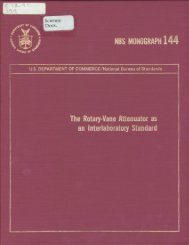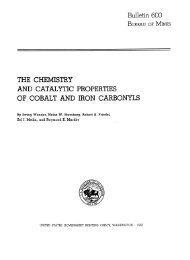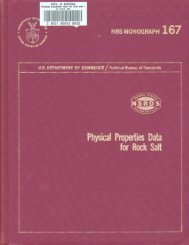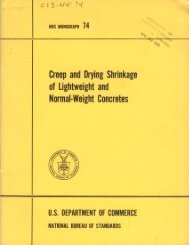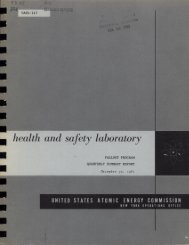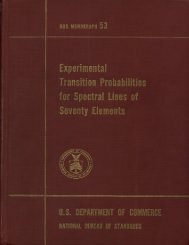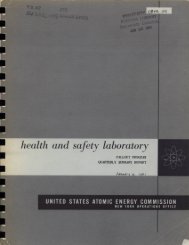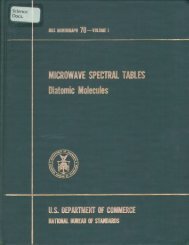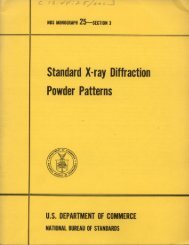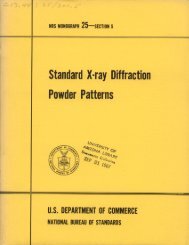Corrosion of Steel Pilings in Soils
Corrosion of Steel Pilings in Soils
Corrosion of Steel Pilings in Soils
- No tags were found...
Create successful ePaper yourself
Turn your PDF publications into a flip-book with our unique Google optimized e-Paper software.
level or <strong>in</strong> the water table zone. At these levels thepile sections are accessible if the need for protectionshould be deemed necessary.It was observed that soil environments which areseverely corrosive to iron and steel buried underdisturbed conditions <strong>in</strong> excavated trenches were notcorrosive to steel pil<strong>in</strong>gs driven <strong>in</strong> the undisturbedsoil. The difference <strong>in</strong> corrosion is attributed tothe differences <strong>in</strong> oxygen concentration. The data<strong>in</strong>dicate that undisturbed soils are so deficient <strong>in</strong>oxygen at levels a few feet below the ground l<strong>in</strong>e orbelow the water table zone, that steel pil<strong>in</strong>gs arenot appreciably affected by corrosion, regardless <strong>of</strong>the soil types or the soil properties. Properties <strong>of</strong>soils such as type, dra<strong>in</strong>age, resistivity, pH or chemical composition are <strong>of</strong> no practical value <strong>in</strong> determ<strong>in</strong><strong>in</strong>g the corrosiveness <strong>of</strong> soils toward steel pil<strong>in</strong>gsdriven underground. This is contrary to everyth<strong>in</strong>gpreviously published perta<strong>in</strong><strong>in</strong>g to the behavior <strong>of</strong>steel under disturbed soil conditions. Hence, it canbe concluded that National Bureau <strong>of</strong> Standardsdata previously published on specimens exposed <strong>in</strong>disturbed soils do not apply to steel pil<strong>in</strong>gs whichare driven <strong>in</strong> undisturbed soils.The author acknowledges the support <strong>in</strong> thisprogram <strong>of</strong> the American Iron and <strong>Steel</strong> Institute,the U.S. Corps <strong>of</strong> Eng<strong>in</strong>eers, and the WaterwaysExperiment Station <strong>of</strong> the Corps <strong>of</strong> Eng<strong>in</strong>eers.The author is especially grateful to the follow<strong>in</strong>g<strong>in</strong>dividuals who rendered assistance by participat<strong>in</strong>g<strong>in</strong> various phases <strong>of</strong> the <strong>in</strong>vestigation: HaroldArdahl, Corps <strong>of</strong> Eng<strong>in</strong>eers, Lower MississippiValley Division; Walter B. Farrar, Corps <strong>of</strong> Eng<strong>in</strong>eers, Office <strong>of</strong> Chief Eng<strong>in</strong>eer; F. E. Fahy, Chairman<strong>of</strong> the Pil<strong>in</strong>g Subcommittee <strong>of</strong> the A.I.S.I. Committee on Build<strong>in</strong>g Research and Technology;C. P. Larrabee, United States <strong>Steel</strong> Company;T. D. Dismuke, Bethlehem <strong>Steel</strong> Company; andW. D. Tryon, Williams-McWilliams Industries, Inc.7. References[1] Melv<strong>in</strong> Roman<strong>of</strong>f, Underground corrosion, NationalBureau <strong>of</strong> Standards Circular 579. U.S. GovernmentPr<strong>in</strong>t<strong>in</strong>g Office, Wash<strong>in</strong>gton 25, D.C., (1957).[2] Paul Anderson, Substructure Analysis and Design, p.139, 2d Ed., The Ronald Press, New York, New York(1956).[3] G. A. Hool and W. S. K<strong>in</strong>ne, Foundations, Abutmentsand Foot<strong>in</strong>gs, p. 204, 2d Ed. ? McGraw-Hill BookCompany, Inc., New York, N.Y., (1943).[4] J. G. Mason and A. L. Ogle, <strong>Steel</strong> pile foundations <strong>in</strong>Nebraska, Civil Eng. 2, No. 9, 533 (1932).[5] Louis Beaudry, Quay wall design and construction, Eng.J. (Canada) 14, 394 (1931).[6] <strong>Steel</strong> shells <strong>in</strong> service 39 years still sound and serviceable,Eng. News-Record 100, No. 15, 590 (Apr. 12, 1928).[7] Life <strong>of</strong> steel sheet pil<strong>in</strong>g, Iron Age 129, No. 23, 1247(June 9, 1932).[8] B. M. Gallaway, A report on some factors affect<strong>in</strong>g thelife <strong>of</strong> steel pil<strong>in</strong>gs <strong>in</strong> the Texas Gulf Coast area,Texas Transportation Institute, College Station,Texas (Oct. 1955).[9] G. G. Greulich, Extracted steel H-piles found <strong>in</strong> goodcondition, Eng. News-Record, 145, No. 8, 41 (Aug.24, 1950).[10] C. V. Brouillette and A. E. Hanna, <strong>Corrosion</strong> survey <strong>of</strong>steel sheet pil<strong>in</strong>g, Tech. Report 097, U.S. Naval CivilEng<strong>in</strong>eer<strong>in</strong>g Laboratory, Port Hueneme, California(Dec. 27, 1960).[11] M. N. Lipp, Some data on beach protection works, CivilEng. 6, No. 5, 291 (1936).[12] C, W. Ross, Deterioration <strong>of</strong> steel sheet pile gro<strong>in</strong>s atPalm Beach, Fla., <strong>Corrosion</strong> 5, No. 10, 339 (1949).[13] A. C. Rayner and C. W. Ross, Durability <strong>of</strong> steel sheetpil<strong>in</strong>gs <strong>in</strong> shore structures, Tech. Memo. No. 12,Beach Erosion Board, Corps <strong>of</strong> Eng<strong>in</strong>eers, U.S. Army(Feb. 1952).[14] Laurits Bjerrum, Norwegian experience with steel pilefoundations to rock, J. Boston Soc. Civil Eng. 44,No. 3, 155 (1957).[15] B. O. Skipp, <strong>Corrosion</strong> and site <strong>in</strong>vestigation, <strong>Corrosion</strong>Technol. 8, No. 9, 269 (Sept. 1961).[16] W. J. Schwerdtfeger, Laboratory measurement <strong>of</strong> thecorrosion <strong>of</strong> ferrous metals <strong>in</strong> soils, J. Research NBS50, 329 (1953).WASHINGTON, D.C.U.S. GOVERNMENT PRINTING OFF1CE:I96222



